Detection and avoidance mechanism of black hole attack on AODV routing protocol in manet using NS2
Security is one of the most important problems in Mobile Ad hoc Network (MANETs) because of
dynamically changing topologies, without centralized coordination system and bandwidth constraint. There
are different types of attack such as Denial of service (DoS), wormhole, replay, masquerade, black hole etc.
The goal of attacks is usually to disrupt the operation of the network or to affect the network performance.
In this paper, we measured multiple black hole attacks simultaneously in Network Simulator 2 (NS2) in
terms of throughput, energy efficiency and data packet delivery. We also proposed a simple solution for
detection and avoidance black hole attacks. Our simulation results show that the more attackable nodes
in network simultaneously, the lower the energy efficiency network performance and if AODV routing
protocol with detection and avoidance mechanism (dam) of black hole attack nodes is deployed in network, the performance of network can be better about 35% in comparison AODV without avoidance.
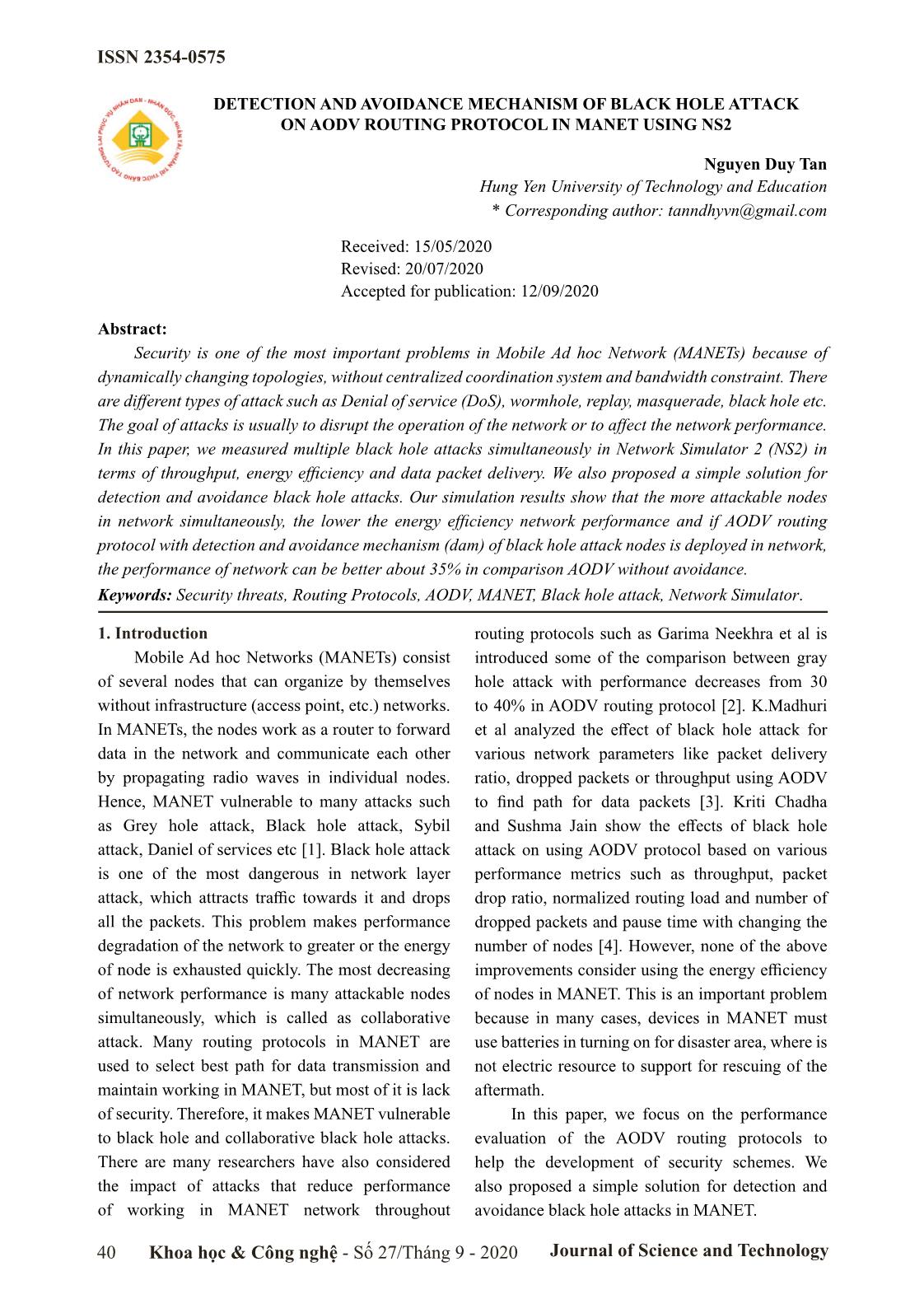
Trang 1
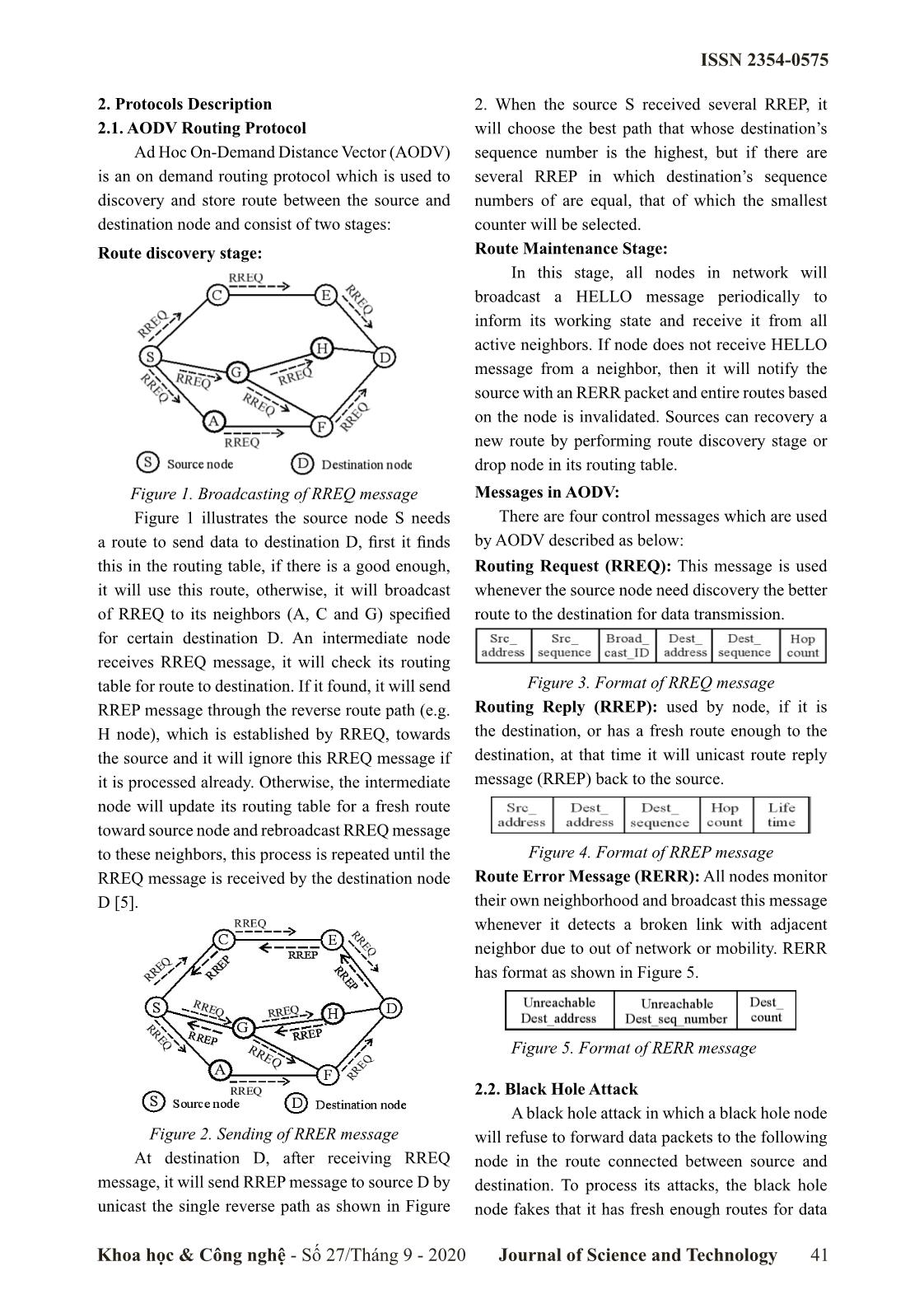
Trang 2
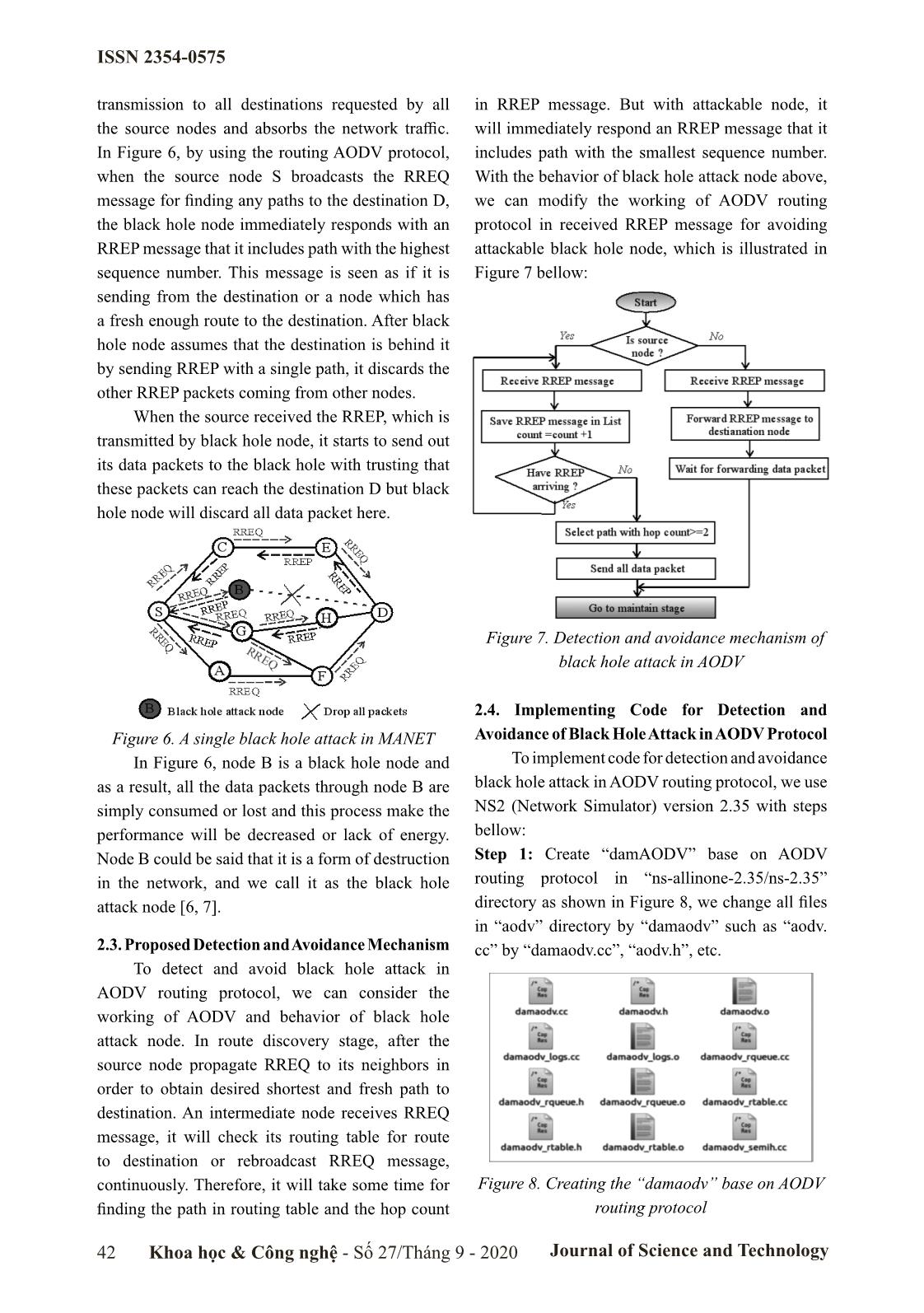
Trang 3
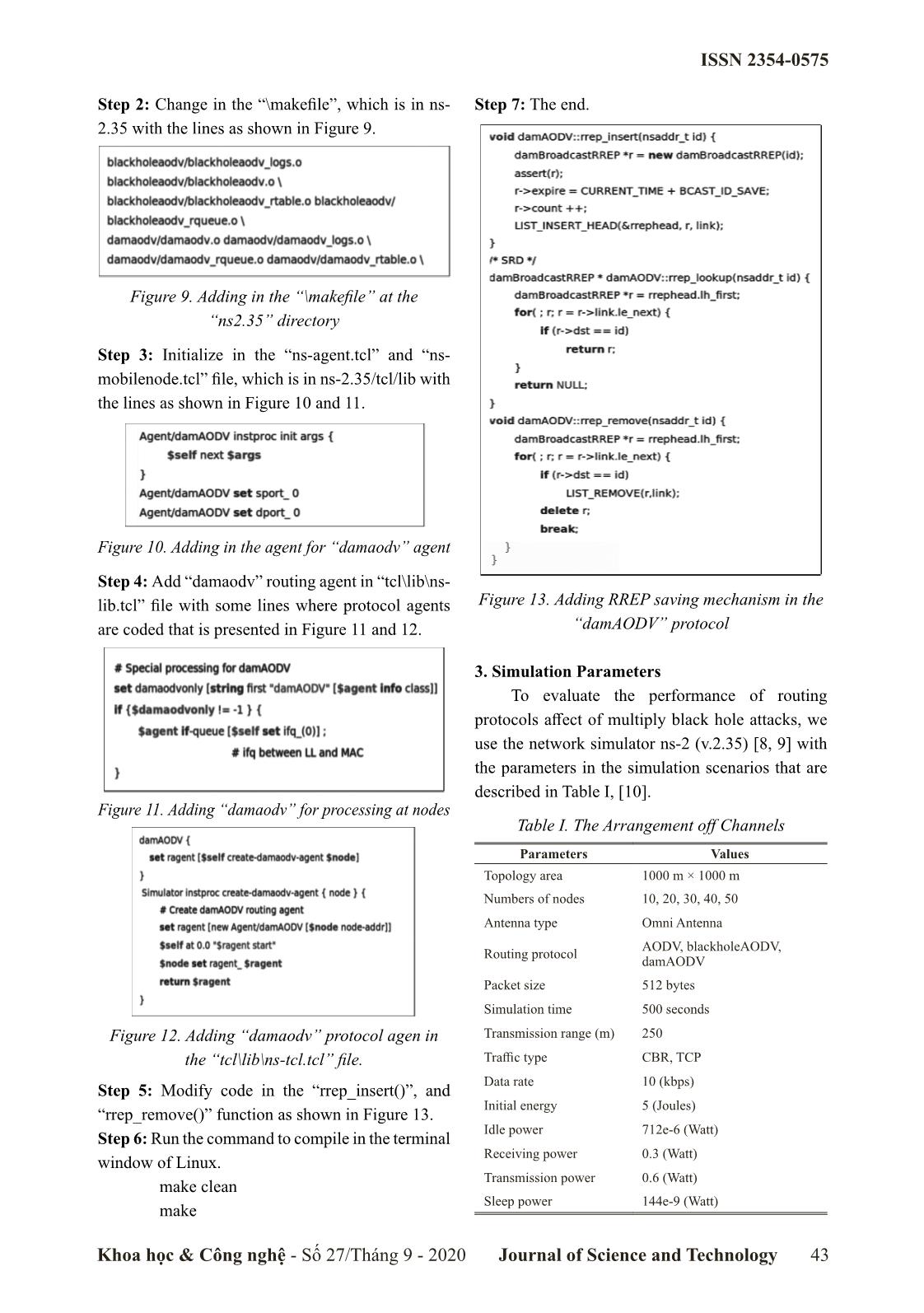
Trang 4
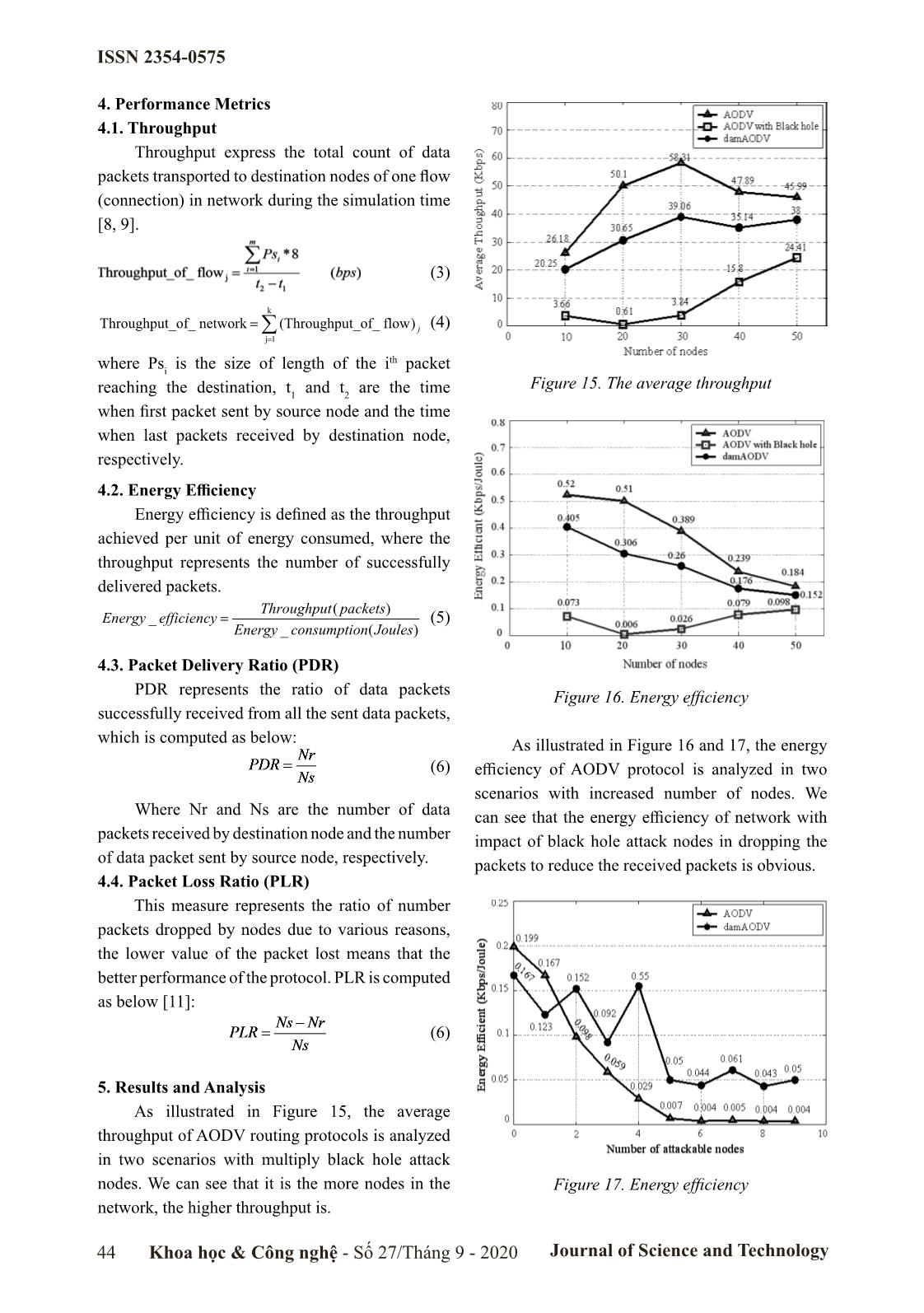
Trang 5
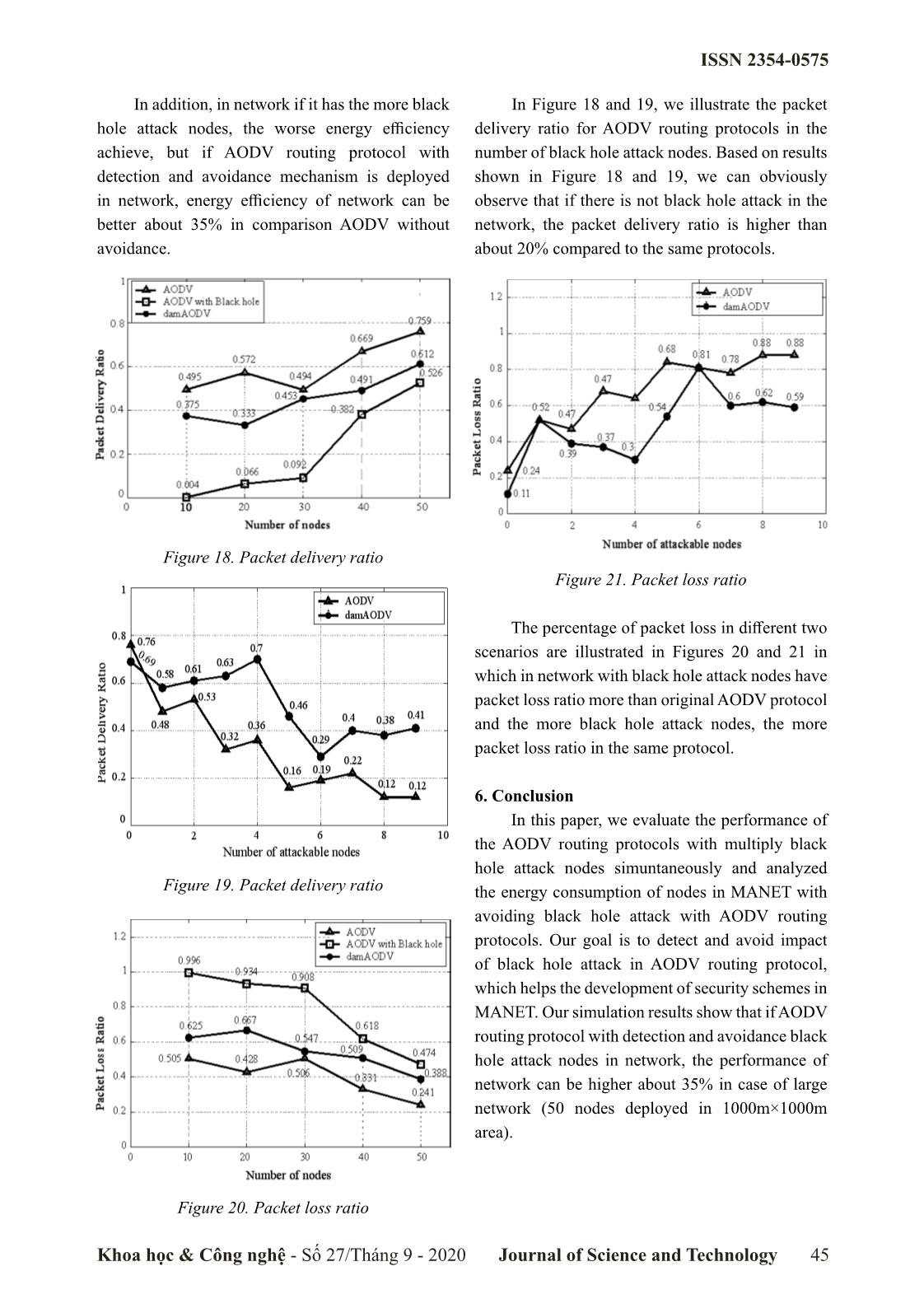
Trang 6
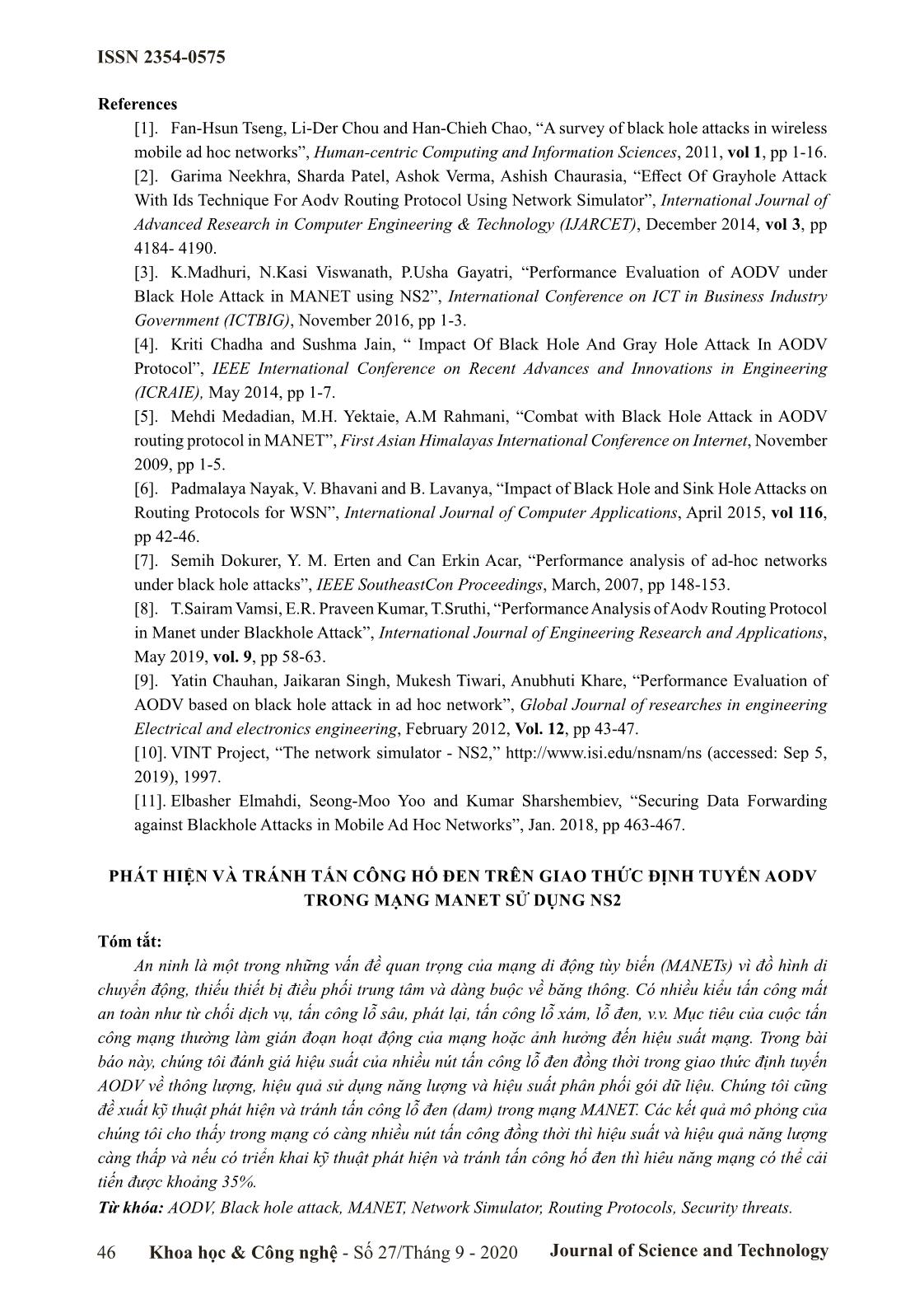
Trang 7
Tóm tắt nội dung tài liệu: Detection and avoidance mechanism of black hole attack on AODV routing protocol in manet using NS2
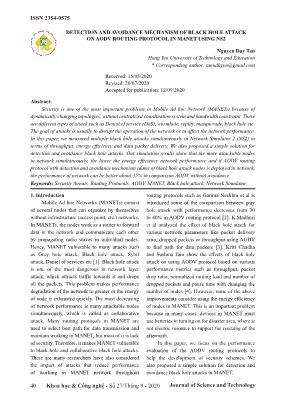
onsist of two stages: counter will be selected. Route discovery stage: Route Maintenance Stage: In this stage, all nodes in network will broadcast a HELLO message periodically to inform its working state and receive it from all active neighbors. If node does not receive HELLO message from a neighbor, then it will notify the source with an RERR packet and entire routes based on the node is invalidated. Sources can recovery a new route by performing route discovery stage or drop node in its routing table. Figure 1. Broadcasting of RREQ message Messages in AODV: Figure 1 illustrates the source node S needs There are four control messages which are used a route to send data to destination D, first it finds by AODV described as below: this in the routing table, if there is a good enough, Routing Request (RREQ): This message is used it will use this route, otherwise, it will broadcast whenever the source node need discovery the better of RREQ to its neighbors (A, C and G) specified route to the destination for data transmission. for certain destination D. An intermediate node receives RREQ message, it will check its routing table for route to destination. If it found, it will send Figure 3. Format of RREQ message RREP message through the reverse route path (e.g. Routing Reply (RREP): used by node, if it is H node), which is established by RREQ, towards the destination, or has a fresh route enough to the the source and it will ignore this RREQ message if destination, at that time it will unicast route reply it is processed already. Otherwise, the intermediate message (RREP) back to the source. node will update its routing table for a fresh route toward source node and rebroadcast RREQ message to these neighbors, this process is repeated until the Figure 4. Format of RREP message RREQ message is received by the destination node Route Error Message (RERR): All nodes monitor D [5]. their own neighborhood and broadcast this message whenever it detects a broken link with adjacent neighbor due to out of network or mobility. RERR has format as shown in Figure 5. Figure 5. Format of RERR message 2.2. Black Hole Attack A black hole attack in which a black hole node Figure 2. Sending of RRER message will refuse to forward data packets to the following At destination D, after receiving RREQ node in the route connected between source and message, it will send RREP message to source D by destination. To process its attacks, the black hole unicast the single reverse path as shown in Figure node fakes that it has fresh enough routes for data Khoa học & Công nghệ - Số 27/Tháng 9 - 2020 Journal of Science and Technology 41 ISSN 2354-0575 transmission to all destinations requested by all in RREP message. But with attackable node, it the source nodes and absorbs the network traffic. will immediately respond an RREP message that it In Figure 6, by using the routing AODV protocol, includes path with the smallest sequence number. when the source node S broadcasts the RREQ With the behavior of black hole attack node above, message for finding any paths to the destination D, we can modify the working of AODV routing the black hole node immediately responds with an protocol in received RREP message for avoiding RREP message that it includes path with the highest attackable black hole node, which is illustrated in sequence number. This message is seen as if it is Figure 7 bellow: sending from the destination or a node which has a fresh enough route to the destination. After black hole node assumes that the destination is behind it by sending RREP with a single path, it discards the other RREP packets coming from other nodes. When the source received the RREP, which is transmitted by black hole node, it starts to send out its data packets to the black hole with trusting that these packets can reach the destination D but black hole node will discard all data packet here. Figure 7. Detection and avoidance mechanism of black hole attack in AODV 2.4. Implementing Code for Detection and Figure 6. A single black hole attack in MANET Avoidance of Black Hole Attack in AODV Protocol In Figure 6, node B is a black hole node and To implement code for detection and avoidance as a result, all the data packets through node B are black hole attack in AODV routing protocol, we use simply consumed or lost and this process make the NS2 (Network Simulator) version 2.35 with steps performance will be decreased or lack of energy. bellow: Node B could be said that it is a form of destruction Step 1: Create “damAODV” base on AODV in the network, and we call it as the black hole routing protocol in “ns-allinone-2.35/ns-2.35” attack node [6, 7]. directory as shown in Figure 8, we change all files in “aodv” directory by “damaodv” such as “aodv. 2.3. Proposed Detection and Avoidance Mechanism cc” by “damaodv.cc”, “aodv.h”, etc. To detect and avoid black hole attack in AODV routing protocol, we can consider the working of AODV and behavior of black hole attack node. In route discovery stage, after the source node propagate RREQ to its neighbors in order to obtain desired shortest and fresh path to destination. An intermediate node receives RREQ message, it will check its routing table for route to destination or rebroadcast RREQ message, continuously. Therefore, it will take some time for Figure 8. Creating the “damaodv” base on AODV finding the path in routing table and the hop count routing protocol 42 Khoa học & Công nghệ - Số 27/Tháng 9 - 2020 Journal of Science and Technology ISSN 2354-0575 Step 2: Change in the “\makefile”, which is in ns- Step 7: The end. 2.35 with the lines as shown in Figure 9. Figure 9. Adding in the “\makefile” at the “ns2.35” directory Step 3: Initialize in the “ns-agent.tcl” and “ns- mobilenode.tcl” file, which is in ns-2.35/tcl/lib with the lines as shown in Figure 10 and 11. Figure 10. Adding in the agent for “damaodv” agent Step 4: Add “damaodv” routing agent in “tcl\lib\ns- lib.tcl” file with some lines where protocol agents Figure 13. Adding RREP saving mechanism in the are coded that is presented in Figure 11 and 12. “damAODV” protocol 3. Simulation Parameters To evaluate the performance of routing protocols affect of multiply black hole attacks, we use the network simulator ns-2 (v.2.35) [8, 9] with the parameters in the simulation scenarios that are described in Table I, [10]. Figure 11. Adding “damaodv” for processing at nodes Table I. The Arrangement off Channels Parameters Values Topology area 1000 m × 1000 m Numbers of nodes 10, 20, 30, 40, 50 Antenna type Omni Antenna AODV, blackholeAODV, Routing protocol damAODV Packet size 512 bytes Simulation time 500 seconds Figure 12. Adding “damaodv” protocol agen in Transmission range (m) 250 the “tcl\lib\ns-tcl.tcl” file. Traffic type CBR, TCP Data rate 10 (kbps) Step 5: Modify code in the “rrep_insert()”, and Initial energy 5 (Joules) “rrep_remove()” function as shown in Figure 13. Idle power 712e-6 (Watt) Step 6: Run the command to compile in the terminal Receiving power 0.3 (Watt) window of Linux. Transmission power 0.6 (Watt) make clean Sleep power 144e-9 (Watt) make Khoa học & Công nghệ - Số 27/Tháng 9 - 2020 Journal of Science and Technology 43 ISSN 2354-0575 4. Performance Metrics 4.1. Throughput Throughput express the total count of data packets transported to destination nodes of one flow (connection) in network during the simulation time [8, 9]. (3) k Throughput_of_ network = ∑(Throughput_of_ flow) j (4) j=1 th where Psi is the size of length of the i packet Figure 15. The average throughput reaching the destination, t1 and t2 are the time when first packet sent by source node and the time when last packets received by destination node, respectively. 4.2. Energy Efficiency Energy efficiency is defined as the throughput achieved per unit of energy consumed, where the throughput represents the number of successfully delivered packets. Throughput( packets) Energy _ efficiency = (5) Energy _ consumption(Joules) 4.3. Packet Delivery Ratio (PDR) PDR represents the ratio of data packets Figure 16. Energy efficiency successfully received from all the sent data packets, which is computed as below: As illustrated in Figure 16 and 17, the energy (6) efficiency of AODV protocol is analyzed intwo scenarios with increased number of nodes. We Where Nr and Ns are the number of data can see that the energy efficiency of network with packets received by destination node and the number impact of black hole attack nodes in dropping the of data packet sent by source node, respectively. packets to reduce the received packets is obvious. 4.4. Packet Loss Ratio (PLR) This measure represents the ratio of number packets dropped by nodes due to various reasons, the lower value of the packet lost means that the better performance of the protocol. PLR is computed as below [11]: (6) 5. Results and Analysis As illustrated in Figure 15, the average throughput of AODV routing protocols is analyzed in two scenarios with multiply black hole attack nodes. We can see that it is the more nodes in the Figure 17. Energy efficiency network, the higher throughput is. 44 Khoa học & Công nghệ - Số 27/Tháng 9 - 2020 Journal of Science and Technology ISSN 2354-0575 In addition, in network if it has the more black In Figure 18 and 19, we illustrate the packet hole attack nodes, the worse energy efficiency delivery ratio for AODV routing protocols in the achieve, but if AODV routing protocol with number of black hole attack nodes. Based on results detection and avoidance mechanism is deployed shown in Figure 18 and 19, we can obviously in network, energy efficiency of network can be observe that if there is not black hole attack in the better about 35% in comparison AODV without network, the packet delivery ratio is higher than avoidance. about 20% compared to the same protocols. Figure 18. Packet delivery ratio Figure 21. Packet loss ratio The percentage of packet loss in different two scenarios are illustrated in Figures 20 and 21 in which in network with black hole attack nodes have packet loss ratio more than original AODV protocol and the more black hole attack nodes, the more packet loss ratio in the same protocol. 6. Conclusion In this paper, we evaluate the performance of the AODV routing protocols with multiply black hole attack nodes simuntaneously and analyzed Figure 19. Packet delivery ratio the energy consumption of nodes in MANET with avoiding black hole attack with AODV routing protocols. Our goal is to detect and avoid impact of black hole attack in AODV routing protocol, which helps the development of security schemes in MANET. Our simulation results show that if AODV routing protocol with detection and avoidance black hole attack nodes in network, the performance of network can be higher about 35% in case of large network (50 nodes deployed in 1000m×1000m area). Figure 20. Packet loss ratio Khoa học & Công nghệ - Số 27/Tháng 9 - 2020 Journal of Science and Technology 45 ISSN 2354-0575 References [1]. Fan-Hsun Tseng, Li-Der Chou and Han-Chieh Chao, “A survey of black hole attacks in wireless mobile ad hoc networks”, Human-centric Computing and Information Sciences, 2011, vol 1, pp 1-16. [2]. Garima Neekhra, Sharda Patel, Ashok Verma, Ashish Chaurasia, “Effect Of Grayhole Attack With Ids Technique For Aodv Routing Protocol Using Network Simulator”, International Journal of Advanced Research in Computer Engineering & Technology (IJARCET), December 2014, vol 3, pp 4184- 4190. [3]. K.Madhuri, N.Kasi Viswanath, P.Usha Gayatri, “Performance Evaluation of AODV under Black Hole Attack in MANET using NS2”, International Conference on ICT in Business Industry Government (ICTBIG), November 2016, pp 1-3. [4]. Kriti Chadha and Sushma Jain, “ Impact Of Black Hole And Gray Hole Attack In AODV Protocol”, IEEE International Conference on Recent Advances and Innovations in Engineering (ICRAIE), May 2014, pp 1-7. [5]. Mehdi Medadian, M.H. Yektaie, A.M Rahmani, “Combat with Black Hole Attack in AODV routing protocol in MANET”, First Asian Himalayas International Conference on Internet, November 2009, pp 1-5. [6]. Padmalaya Nayak, V. Bhavani and B. Lavanya, “Impact of Black Hole and Sink Hole Attacks on Routing Protocols for WSN”, International Journal of Computer Applications, April 2015, vol 116, pp 42-46. [7]. Semih Dokurer, Y. M. Erten and Can Erkin Acar, “Performance analysis of ad-hoc networks under black hole attacks”, IEEE SoutheastCon Proceedings, March, 2007, pp 148-153. [8]. T.Sairam Vamsi, E.R. Praveen Kumar, T.Sruthi, “Performance Analysis of Aodv Routing Protocol in Manet under Blackhole Attack”, International Journal of Engineering Research and Applications, May 2019, vol. 9, pp 58-63. [9]. Yatin Chauhan, Jaikaran Singh, Mukesh Tiwari, Anubhuti Khare, “Performance Evaluation of AODV based on black hole attack in ad hoc network”, Global Journal of researches in engineering Electrical and electronics engineering, February 2012, Vol. 12, pp 43-47. [10]. VINT Project, “The network simulator - NS2,” (accessed: Sep 5, 2019), 1997. [11]. Elbasher Elmahdi, Seong-Moo Yoo and Kumar Sharshembiev, “Securing Data Forwarding against Blackhole Attacks in Mobile Ad Hoc Networks”, Jan. 2018, pp 463-467. PHÁT HIỆN VÀ TRÁNH TẤN CÔNG HỐ ĐEN TRÊN GIAO THỨC ĐỊNH TUYẾN AODV TRONG MẠNG MANET SỬ DỤNG NS2 Tóm tắt: An ninh là một trong những vấn đề quan trọng của mạng di động tùy biến (MANETs) vì đồ hình di chuyển động, thiếu thiết bị điều phối trung tâm và dàng buộc về băng thông. Có nhiều kiểu tấn công mất an toàn như từ chối dịch vụ, tấn công lỗ sâu, phát lại, tấn công lỗ xám, lỗ đen, v.v. Mục tiêu của cuộc tấn công mạng thường làm gián đoạn hoạt động của mạng hoặc ảnh hưởng đến hiệu suất mạng. Trong bài báo này, chúng tôi đánh giá hiệu suất của nhiều nút tấn công lỗ đen đồng thời trong giao thức định tuyến AODV về thông lượng, hiệu quả sử dụng năng lượng và hiệu suất phân phối gói dữ liệu. Chúng tôi cũng đề xuất kỹ thuật phát hiện và tránh tấn công lỗ đen (dam) trong mạng MANET. Các kết quả mô phỏng của chúng tôi cho thấy trong mạng có càng nhiều nút tấn công đồng thời thì hiệu suất và hiệu quả năng lượng càng thấp và nếu có triển khai kỹ thuật phát hiện và tránh tấn công hố đen thì hiêu năng mạng có thể cải tiến được khoảng 35%. Từ khóa: AODV, Black hole attack, MANET, Network Simulator, Routing Protocols, Security threats. 46 Khoa học & Công nghệ - Số 27/Tháng 9 - 2020 Journal of Science and Technology
File đính kèm:
 detection_and_avoidance_mechanism_of_black_hole_attack_on_ao.pdf
detection_and_avoidance_mechanism_of_black_hole_attack_on_ao.pdf

